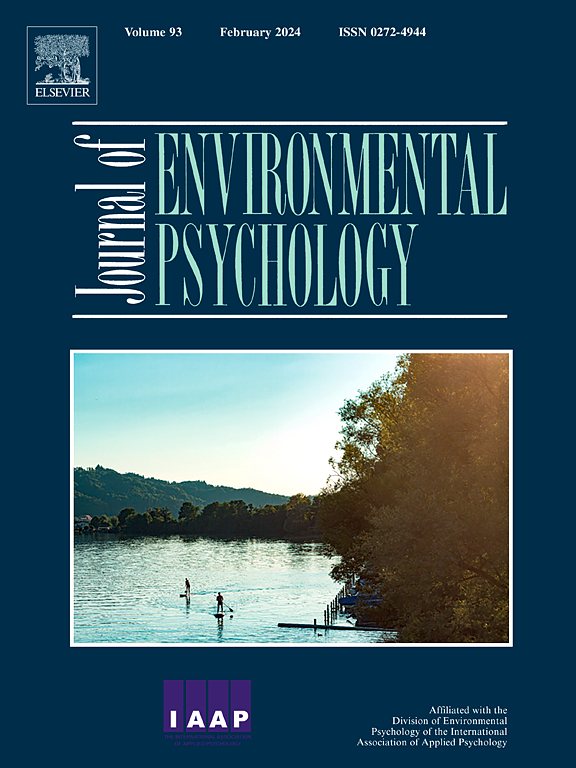Expanding self-determination theory: Examining the role of nature relatedness in agroforestry adoption among Indigenous landholders in Mexico
IF 7
1区 心理学
Q1 ENVIRONMENTAL STUDIES
引用次数: 0
Abstract
Understanding what motivates land users to adopt conservation practices is of central importance for mitigating climate change and biodiversity loss. But fostering adoption alone is not enough. The intensity and scope of behavior change, along with the longitudinal patterns of adoption are instrumental in achieving conservation solutions and must also be addressed. We tested an expanded self-determination theory (SDT) to understand the reasons why autonomous motivations shaped behavior among Indigenous land users in Yucatan, Mexico. We first conducted semi-structured interviews and then surveyed residents from 28 communities who were participating in a national agroforestry program called Sembrando Vida (“Sowing Life”). Results from a thematic analysis of qualitative data and a theoretically derived path model demonstrated the applicability of SDT to understand select psychological needs of Indigenous communities. We also highlighted the need to adapt psychometric measurement through in situ testing that aligns with culturally distinct populations. Given that the motivational forces undergirding behavior change have largely been studied in Western, Educated, Industrialized, Rich and Democratic nations (“WEIRD”), we offer new insight into the reasons why non-WEIRD cultures may be autonomously motivated to adopt practices that benefit the environment. We also suggest that nature relatedness was positively associated with autonomous motivation, and in turn, the adoption intensity of agroforestry practices. The inclusion of Indigenous people's connection to nature in SDT reveals a pathway for strengthening SDT and informing more culturally sensitive conservation research and interventions.
扩展自决理论:考察自然关系在墨西哥土著土地所有者采用农林业中的作用
了解是什么促使土地使用者采取保护措施,对于减缓气候变化和生物多样性丧失至关重要。但是仅仅促进收养是不够的。行为改变的强度和范围以及采用的纵向模式有助于实现保护解决办法,也必须加以处理。我们测试了一个扩展的自决理论(SDT)来理解为什么自主动机影响了墨西哥尤卡坦地区土著土地使用者的行为。我们首先进行了半结构化访谈,然后调查了来自28个社区的居民,他们参加了一个名为Sembrando Vida(“播种生命”)的国家农林业项目。对定性数据的专题分析和理论推导路径模型的结果表明,SDT适用于理解土著社区的特定心理需求。我们还强调了通过与文化不同的人群相一致的原位测试来适应心理测量的必要性。鉴于行为改变背后的动机力量已经在西方、受过教育的、工业化的、富裕的和民主的国家(“WEIRD”)得到了很大程度的研究,我们提供了新的见解,来解释为什么非WEIRD文化可能会自主地采取有利于环境的做法。我们还认为,自然关联与自主动机呈正相关,进而与农林业实践的采用强度呈正相关。将土著人民与自然的联系纳入SDT,揭示了加强SDT和为更具文化敏感性的保护研究和干预提供信息的途径。
本文章由计算机程序翻译,如有差异,请以英文原文为准。
求助全文
约1分钟内获得全文
求助全文
来源期刊

Journal of Environmental Psychology
Multiple-
CiteScore
10.60
自引率
8.70%
发文量
140
审稿时长
62 days
期刊介绍:
The Journal of Environmental Psychology is the premier journal in the field, serving individuals in a wide range of disciplines who have an interest in the scientific study of the transactions and interrelationships between people and their surroundings (including built, social, natural and virtual environments, the use and abuse of nature and natural resources, and sustainability-related behavior). The journal publishes internationally contributed empirical studies and reviews of research on these topics that advance new insights. As an important forum for the field, the journal publishes some of the most influential papers in the discipline that reflect the scientific development of environmental psychology. Contributions on theoretical, methodological, and practical aspects of all human-environment interactions are welcome, along with innovative or interdisciplinary approaches that have a psychological emphasis. Research areas include: •Psychological and behavioral aspects of people and nature •Cognitive mapping, spatial cognition and wayfinding •Ecological consequences of human actions •Theories of place, place attachment, and place identity •Environmental risks and hazards: perception, behavior, and management •Perception and evaluation of buildings and natural landscapes •Effects of physical and natural settings on human cognition and health •Theories of proenvironmental behavior, norms, attitudes, and personality •Psychology of sustainability and climate change •Psychological aspects of resource management and crises •Social use of space: crowding, privacy, territoriality, personal space •Design of, and experiences related to, the physical aspects of workplaces, schools, residences, public buildings and public space
 求助内容:
求助内容: 应助结果提醒方式:
应助结果提醒方式:


